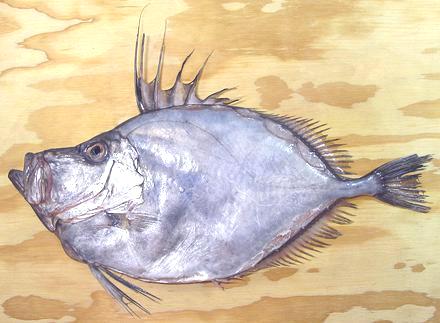 [Sailfin Dory; Zenopsis conchifer]
[Sailfin Dory; Zenopsis conchifer]
This fish is not the famous John Dory of European cuisine, though looks a lot like it except for color. Silvery John Dory is native to both sides of the Atlantic, from sub-Arctic down to Argentina and South Africa. It is also found in the Indian Ocean from South Africa around to Indonesia and northwest Australia. It is not found in the Pacific at all. This fish can grow to 31-1/2 inches long and 7 pounds, but the photo specimen was 21 inches long and 3-1/2 pounds, a typical size. Silvery John Dory is IUCN Red Listed NE (Not Evaluated) but is not considered threatened. It has no scales, so is not kosher.
Silvery John Dory is not a good swimmer and catches it's prey by sneaking up on it. It then suddenly extends its mouth into a long tunnel and sucks the pray in. It is distinguished by a row of hard bony scutes along the bottom edge for the full length of the body cavity, and hard bony bucklers, each with a thorn on it, for the full length of the bases of the dorsal and anal fins.
More on Varieties of Fish
(very large page).
The flesh of skinless fillets is white and cooks well for both wet and dry cooking methods. It is firm enough for poaching and flakes apart easily on the plate. The taste is, however, rather bland, so I don't recommend poaching. Dusting it with rice flour and pan frying in pure or pomace olive oil until light blonde in color gives it enough flavor to be enjoyable.
Buying: This fish is hardly ever seen in the Asian markets here in Los Angeles, probably because it is not found in the Pacific Ocean at all. The photo specimen was purchased at a Philippine market in Los Angeles (Eagle Rock) for 2016 US $1.99 per pound.
Scales: This fish has no scales at all. It does have hard bony scutes along the bottom edge for the full length of the body cavity , and hard bony bucklers along the bases of the dorsal and anal fins, but these don't count for being kosher because they can't be scraped off.
Cleaning: To clean this fish, I cut in from both sides of the row of scutes and pull them off. This completely opens the body cavity. The cavity is large and filled with a lot of messy stuff. The throat is very large and needs to be cut off with kitchen shears. Then cut away the head. I do not pull the gills because the head is of no use. With the head off it is easy to finish cleaning up the body cavity.
Fillet: The main impediment for filleting is the rows of bony bucklers. I cut under them from both sides with my filleting knife, from the side opposite the fin. I then bend them outward and cut off the bucklers and fins with strong kitchen shears. At this point, the fish is easy to fillet, as there are good fin rays and bones to follow. When I cut forward to the body cavity, I cut it from the backbone with kitchen shears. The fillet skirts have lines like they have ribs, but there are no ribs in them. There are some sharp centerline pinbones to be located and pulled for the length of the body cavity.
Skin: The skin has an oily taste stronger than the flesh, and considerable shrink if fried. Even if you don't mind the taste, you need to skin fillets, because the skin immediately turns to mush and sticks to the pan and your turner, even when powdered with rice flour.
Fillets can be skinned rather easily using the long knife and cutting board Method, but with a few preparation steps. First, make a diagonal cut taking off the entire skirt. The flesh in this region has no integrity and simply turns to mush when skinned. Second, you are going to end up with three fillets from one, whether you want to or not, so you might as well make skinning easy by separating them now. There is a seam that opens all the way through to the skin between the main fillet and the big triangle left from cutting off the skirt. There is another for the full length of the main fillet, dividing it into a wider upper fillet and a narrower lower fillet. Spread these seams and cut through the skin to separate them before skinning.
Yield: A 3-1/2 pound fish yielded 1 pound skin-off fillet (29%), a low yield because of losing the skirt area. It would be 42% skin-on and skirt on, but a skin-on fillet is of no use.
Stock: The head, bones and fins make a very muddy looking stock. I didn't bother tasting it because it was visually unacceptable.
sf_jdoryz 160516 - www.clovegarden.com